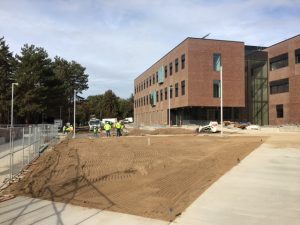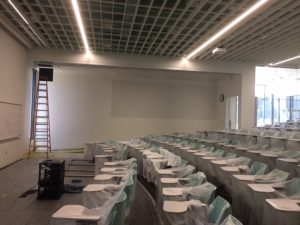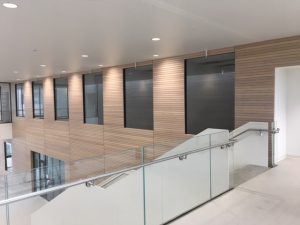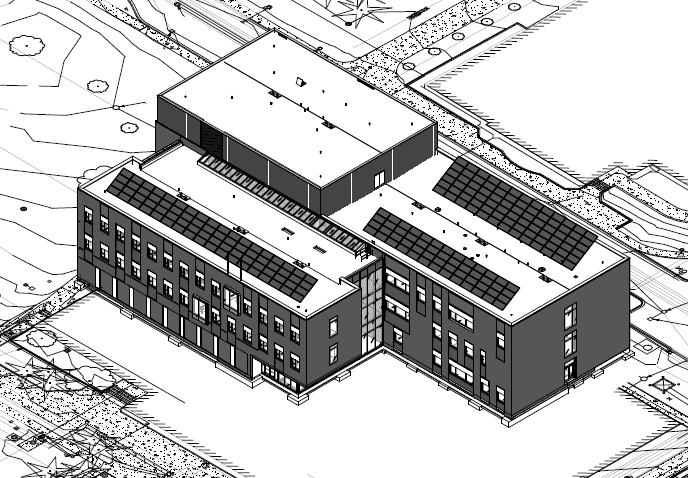$60 million building set to open in January 2022
November 4, 2021
CWU’s latest construction project is drawing to a close this winter as the Health Sciences program prepares to inhabit its new home.
The Health Sciences building will be three stories tall, house over 600 students and cost an estimated $60 million, according to the CWU website.
As students enter the building set to open its doors in January 2022, they will see multiple new simulation laboratories according to University Facilities Planning Officer Doug Ryder.
A Number of Programs Hosted Here
According to Health Sciences Department Chair Ethan Bergman, the building will host five undergraduate programs: Clinical Physiology, Exercise Science, Food Science and Nutrition, Paramedicine and Public Health. The building will also host three graduate programs: Integrative Human Physiology, Nutrition and Public Health.

The new facility will prepare students to go into graduate nursing programs, physician’s assistant programs, doctorates in physical therapy or occupational therapy and many other fields, according to Clinical Physiology Professor Vincent Nethery.
“If there are community challenges that exist, quite likely some of the expertise in that building will be able to help resolve community concerns or be able to answer questions,” Nethery said.
The regionally renowned Health Sciences program will gain lots of useful technology in this building, according to Ryder.
“This facility is going to be great for our students because it allows better hands-on learning,” Ryder said. “Our paramedics and EMT students will have simulators in the building. [There will be] a biomechanics laboratory, and a new anatomy laboratory that will be used by all of the sciences on campus.”
Simulation Laboratories Offer Near Real World Experience
Ryder said the paramedic students will be able to practice with brand new ambulance simulators using mannequins or other students.
“We’re going to have a state-of-the-art cadaver lab with eight cadavers in it, which is really exciting,” Bergman said. “There is an environmental chamber that is going to be able to simulate different environmental conditions like heat and cold, also elevation changes so we can see the physiological response of people in those circumstances.”
The new building will include a hospital room simulator and a clinical exam room simulator for students to practice.

“We’ve got a … food production kitchen and a food-tasting area that is going to be really great for our Food Science and Nutrition program,” Bergman said. “We have a morphology lab that is going to have all the different ways to measure and estimate body composition.”
Faculty involved with the building are looking forward to laboratories that will provide students with practical experience for their careers.
“Another part of their laboratory space includes an apartment simulator [with] a kitchen, bathroom and living room,” Ryder said.
This simulator will help students prepare for difficult situations that require assistance, like a person falling out of bed or falling in their bathroom at home.
According to Ryder, there are video cameras in the simulation laboratories so students can play back their work and receive critique.
“When they go out on their first calls as a paramedic, they’ll have a lot more confidence and a lot more experience,” Ryder said. “[They’ll] be much better prepared for helping people in the community.”
New Upgrades Create New Opportunities
With so many upgrades in this facility that directly impact learning, CWU is eager to open the doors of the Health Sciences building.
Nethery expressed excitement about all the Health Sciences programs residing in one building for the first time.
“At the moment, this department is spread all over the campus across six or seven buildings,” Nethery said. “There’s no home for Health Sciences on this campus and in January there will be. The laboratory components that they teach students with right now are very much make-shift. Equipment is minimal. This will provide … enhancement of the instructional component and the types of experiences that students will be able to undertake in the classroom.”

Students will experience cutting edge innovation in eco-friendly energy sources as well.
“It’s really an exceptionally designed building,” Ryder said. “It’s very energy efficient, it has lots of natural daylight and has 9,000 square feet of solar panels.”
Ryder said the heating and cooling system will use recovered heat from the exhaust jack on the campus boiler. Costs of gas and electricity will be lowered once this system is implemented.
Cost effective measures benefit students and taxpayers alike, while measures to preserve the environment are necessary to combat climate change. Parking for electric vehicles will be available outside the building to promote energy efficiency.
According to Ryder, the project has experienced some pandemic related delays but their general contractors and vendors have worked hard to ensure the building will be open for winter quarter.
“I think that’s a testament to all the people involved, including our consultants LMN Architects, our contractor T.W. Clark [Construction], and all of their subconsultants and subcontractors that have done an excellent job for our project,” Director of Capital Planning and Projects Delano Palmer said.
Palmer said he was proud that the CWU Facilities and Planning teams completed a “masterful and successful project during the middle of a pandemic.”
2022 Construction Projects on Campus
- Expansion to Southeast side of Nicholson Pavilion, connecting to Purser Hall for Health Education
- Electrical feed maintenance on North side of campus
- Replacement of Barge Hall roof
- Brick tuck pointing for Barge Hall
- Update of McConnell Hall elevator
- Update of fire alarm panels in Barge Hall and Discovery Hall
- Update of fume hood digital controls and ventilation in Science building
- Landscaping that includes irrigation control and tree replacements
- Roughly $700,000 worth of IT and IS modernization for data infrastructure
- Over $500,000 to update building metering to improve energy efficiency
- Improvement of sidewalks and concrete around campus


